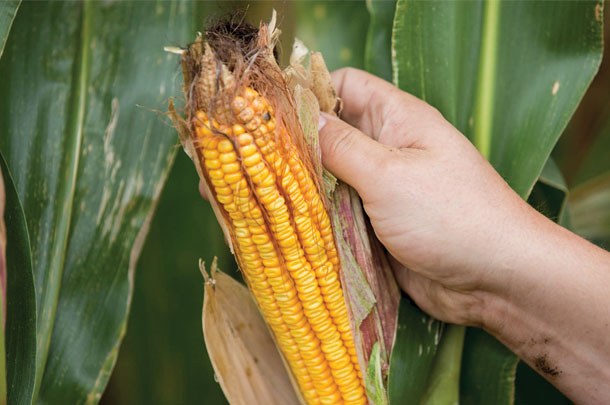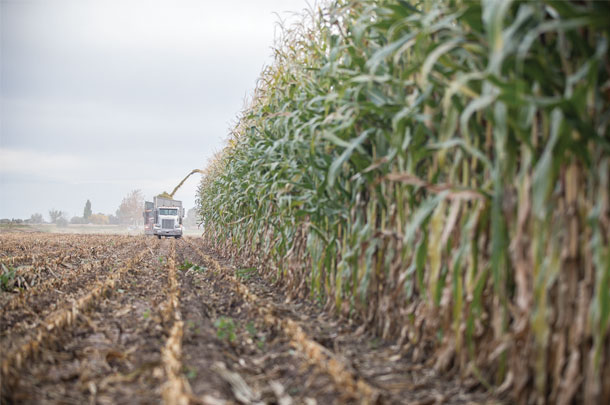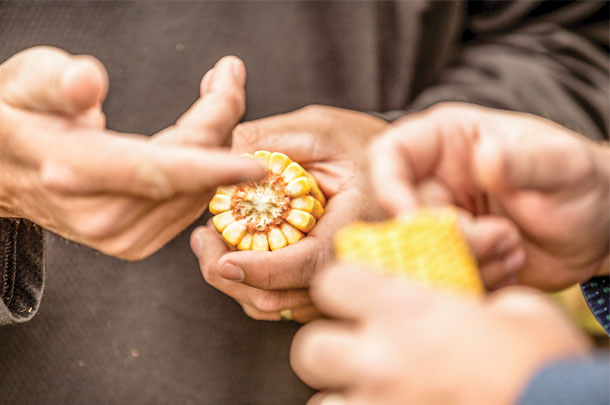Being a producer in today’s market means constantly seeking ways to move your herd’s production to the next level. When it comes to nutrition, it’s all about making the ration as productive and efficient as possible.
Every dairy farmer approaches nutrition differently; no rations are the same from farm to farm. But a solid foundation starts with a high-forage diet composed of corn silage with high neutral detergent fiber digestibility and starch that, ideally, is also very digestible. This combination helps increase dry matter intake and improve rumen health, which translates to stronger performance in milk production and components.
Throughout the last two decades, fiber digestibility has become more accessible through the development of silage-specific hybrids and BMR corn silage. But starch digestibility has remained elusive. Producers needed to turn to kernel processing or supplement the ration with added starch.
 John Koepke, a Wisconsin dairy producer, knows one of the dairy industry’s biggest challenges is getting digestible starch from corn silage hybrids.
John Koepke, a Wisconsin dairy producer, knows one of the dairy industry’s biggest challenges is getting digestible starch from corn silage hybrids.
“A lot of the grain corn hybrids out there today are bred so the kernel doesn’t fall apart when it’s transported 10,000 miles to its final destination,” Koepke says.
“That’s great for shipping, handling and merchandising, but it’s not so great when you have to feed it to livestock. Cows like things that digest and break apart easily.”
Now there is a new option for dairy producers looking for fiber digestibility and highly digestible starch in one corn silage hybrid.
The best of both worlds
In 2005, Michigan State University scientists published research in the Journal of Dairy Science on a gene that increases the starch digestibility of the grain. Steve Plehn, one of our silage corn breeders, read this paper and began work to breed a soft kernel into a corn silage hybrid with high fiber digestibility.
“It has been my goal from the get-go to leverage soft kernel technology because it offers fantastic financial advantages for dairy producers,” Plehn said. “When you have an opportunity to put your energy and work into something that can make a significant difference for the dairy industry, it’s very fulfilling.”

After 12 years of breeding, research and feeding trials, Plehn and his teammates developed and released a corn silage hybrid that combines a softer kernel for increased starch digestibility with high fiber digestibility.
The next step in silage
Over the years, the seed industry has increased the quality and value of corn silage hybrids. These corn silage products allow dairy farmers to feed more corn silage and, potentially, remove expensive concentrates previously added to meet the herd’s digestible starch needs. This reduces costs while increasing productivity.
In addition to increased milk production, the softer kernel offers advantages during harvest, in storage and at the feedbunk. It’s more forgiving at harvest, as it has a wider harvest window, and enables earlier feedout, as the softer kernel requires less fermentation time as the starch is more digestible.
Studies show advantages
In 2015, the William H. Miner Agricultural Research Institute conducted a feeding trial with the new silage product to determine its nutritional composition and impact on milk production and components. The study monitored cows being fed three rations: conventional corn silage, bm3 BMR corn silage and corn silage incorporating the new soft-kernel characteristic. Rations were fed in three 28-day rotations.

“The research demonstrated the advantage of having a product that combines both fiber and starch digestibility,” says Rick Grant, president of the William H. Miner Agricultural Research Institute, which specializes in dairy cattle nutrition research.
Results showed a 7 percent increase in feed efficiency compared with non-BMR hybrids as well as an advantage of 10.1 more pounds of energy-corrected milk per cow per day. Data also shows a 7 percent increase in butterfat and 13 percent increase in protein compared with non-BMR hybrids.
“This will give producers a lot more flexibility. They should be able to feed higher-forage diets, have more flexibility in how they formulate their rations and be able to feed the rumen more efficiently,” Grant says.
For producers, it’s all about digestibility
 Ron Gibson of Gibson Green Acres in Ogden, Utah, and John Koepke of Koepke Farms in Oconomowoc, Wisconsin, participated in on-farm trials using a soft-kernel hybrid in 2016.
Ron Gibson of Gibson Green Acres in Ogden, Utah, and John Koepke of Koepke Farms in Oconomowoc, Wisconsin, participated in on-farm trials using a soft-kernel hybrid in 2016.
Both Gibson and Koepke are constantly seeking ways to improve feed efficiency and get the most from their acres.
“We need to make sure we can get the maximum amount of milk production for every acre we have,” Gibson says. “Now we’re going to have a digestible plant with a more digestible ear, and it’s all focused on success of the dairy farm.”
Koepke and Gibson worked with agronomy and nutrition teams to manage the trials in the field and the feedbunk. The corn silage received a fungicide application mid-season, and the producers followed standard practices at harvest for chop length and kernel processing.
After fermenting for barely six weeks, they began testing the corn silage and feeding it.
“After we got forage test results back, we balanced our diet to meet the nutritional requirements of our herd,” Koepke says. “The process was the same as with any new silage product we introduce on our farm.”

Gibson and Koepke monitored milk output and components and recorded increases in both protein and butterfat.
“We saw a significant fat-corrected milk increase of 4 to 5 pounds as well as better feed efficiency compared to our bm3 BMR,” Koepke says. “So we made more milk from less feed. It doesn’t get any better than that.”
Gibson experienced similar results. “We immediately saw an increase in milk production, and we experienced better feed efficiency,” Gibson says. “We’re hoping that by feeding it for a longer period of time this year, we can monitor across six months or a year and see what positive impact the new silage might have on reproduction and cow health.
“Every pound of milk is so valuable to the bottom line of a dairy operation. “When you can get more production out of the exact same inputs, you’re so much better off.” ![]()
PHOTO 1: John Koepke of Koepke Family Farms in Oconomowoc, Wisconsin, trialed a soft-kernel corn silage hybrid and experienced an increase of milk production within a few days of incorporating it within the ration.
PHOTO 2: New genetics provide a softer kernel for improved starch digestibility.
PHOTO 3: Whole-plant digestibility brings the opportunity for increased feed efficiency in this new hybrid.
PHOTO 4: Ron Gibson of Gibson’s Green Acres in Ogden, Utah, is focused on the success of the dairy farm. That means a more digestible plant for an increase in milk production.
PHOTO 5: A softer kernel increases starch digestibility within the ration. Photos provided by Mycogen Seeds.
References omitted but are available upon request. Click here to emai an editor.

-
John Anderson
- Dairy Nutritionist - Nutrition Team Leader
- Mycogen Seeds
- Email John Anderson





